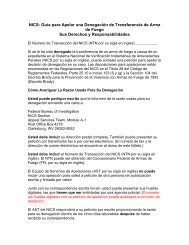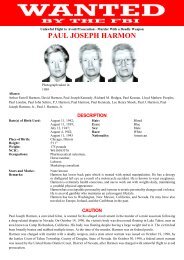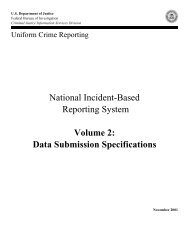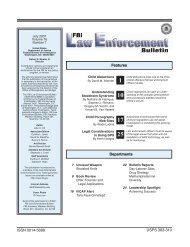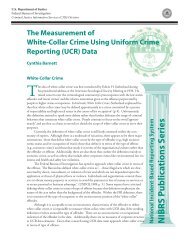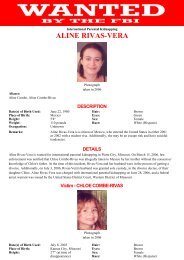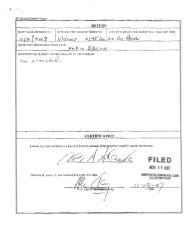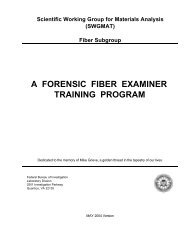F B I Law Enforcement Bulletin - June 2003 Issue
F B I Law Enforcement Bulletin - June 2003 Issue
F B I Law Enforcement Bulletin - June 2003 Issue
You also want an ePaper? Increase the reach of your titles
YUMPU automatically turns print PDFs into web optimized ePapers that Google loves.
With this information in mind,<br />
law enforcement supervisors must<br />
understand the dangers that work<br />
addiction presents. These supervisors<br />
also must remember that they<br />
have an ethical responsibility to<br />
intervene when they observe the<br />
telltale signs of the work-addicted<br />
personality.<br />
A New Covenant<br />
Perhaps, the poet Robert Frost<br />
had Chief Smith in mind when he<br />
observed, “By working faithfully 8<br />
hours a day, you may eventually get<br />
to be boss and work 12 hours a<br />
day.” Certainly, expectations run<br />
high in the law enforcement profession.<br />
Establishing and maintaining<br />
relationships creates tremendous<br />
demands on time, resources, and<br />
energy; life balance easily becomes<br />
lost. The wise boss must understand<br />
and accept this reality.<br />
Twenty-first century police<br />
management has embraced a sea of<br />
change. Police supervisors now<br />
routinely use technology to gather<br />
and analyze data across the full<br />
spectrum of police performance<br />
measures, and, more important,<br />
they hold officers accountable for<br />
results. Today, supervisors acknowledge<br />
a new covenant, which<br />
demands that they set out quantifiable<br />
work standards to measure<br />
work performance.<br />
Prudent and ethical supervisors<br />
must measure subordinate productivity<br />
in many ways. They must consider<br />
the relative limits of what can<br />
be reasonably achieved by different<br />
officers, with diverse skills and<br />
abilities, across the spectrum of assignments<br />
and work shifts, as well<br />
as family and personal situations.<br />
Supervisors must understand that<br />
officers have different tolerance<br />
levels to manage the personal, as<br />
well as the professional, issues that<br />
they encounter. Most important,<br />
commanders must realize that the<br />
quickest route to supervisory negligence<br />
is a shortsighted focus on results,<br />
not people.<br />
Conclusion<br />
While law enforcement professionals<br />
should possess a strong<br />
sense of duty and responsibility for<br />
the public’s welfare, they must not<br />
forget the well-being of their families,<br />
friends, and, most important,<br />
themselves. The sad lesson of Chief<br />
William Smith demonstrates the<br />
need for officers to take the longterm<br />
view, beyond the crisis of the<br />
moment. Thomas Merton, a<br />
Trappist monk and prominent author,<br />
said, “We cannot be happy if<br />
we expect to live all the time at the<br />
highest peak of intensity. Happiness<br />
is not a matter of intensity, but of<br />
balance and order and rhythm and<br />
harmony.” The real challenge for<br />
law enforcement professionals rests<br />
with at least seeking, if not achieving,<br />
that balance for their families,<br />
their peers, their communities, and,<br />
most of all, themselves. In so doing,<br />
they will become better spouses,<br />
friends, coworkers, and officers<br />
who value their work, but do not let<br />
it overwhelm their lives.<br />
Endnotes<br />
1 B.E. Robinson, Chained to the Desk (New<br />
York, NY: New York University Press, 1998), 3.<br />
2 B. Killinger, Workaholics: The Respectable<br />
Addicts (Buffalo, NY: Firefly Books,<br />
1991).<br />
3 Supra note 1, 75.<br />
4 Supra note 2.<br />
5 W.E. Oates, Confessions of a Workaholic<br />
(New York, NY: Abingdon Press, 1971), 4.<br />
6 Supra note 2, 6.<br />
T<br />
Wanted:<br />
Photographs<br />
he <strong>Bulletin</strong> staff is<br />
always on the lookout<br />
for dynamic, law enforcement-related<br />
photos for<br />
possible publication in the<br />
magazine. We are interested<br />
in photos that visually depict<br />
the many aspects of the law<br />
enforcement profession and<br />
illustrate the various tasks<br />
law enforcement personnel<br />
perform.<br />
We can use either blackand-white<br />
glossy or color<br />
prints or slides, although we<br />
prefer prints (5x7 or 8x10).<br />
We will give appropriate<br />
credit to photographers when<br />
their work appears in the<br />
magazine. Contributors<br />
should send duplicate, not<br />
original, prints as we do not<br />
accept responsibility for<br />
damaged or lost prints. Send<br />
photographs to:<br />
Art Director<br />
FBI <strong>Law</strong> <strong>Enforcement</strong><br />
<strong>Bulletin</strong>, FBI Academy,<br />
Madison Building,<br />
Room 209, Quantico,<br />
VA 22135.<br />
<strong>June</strong> <strong>2003</strong> / 17




